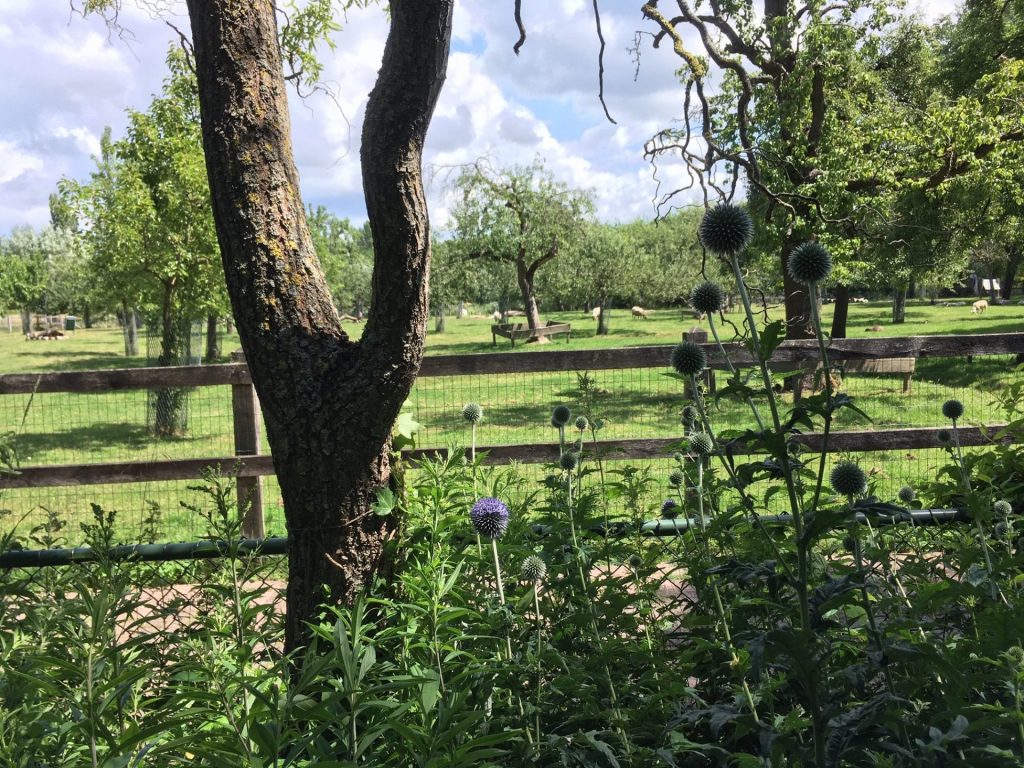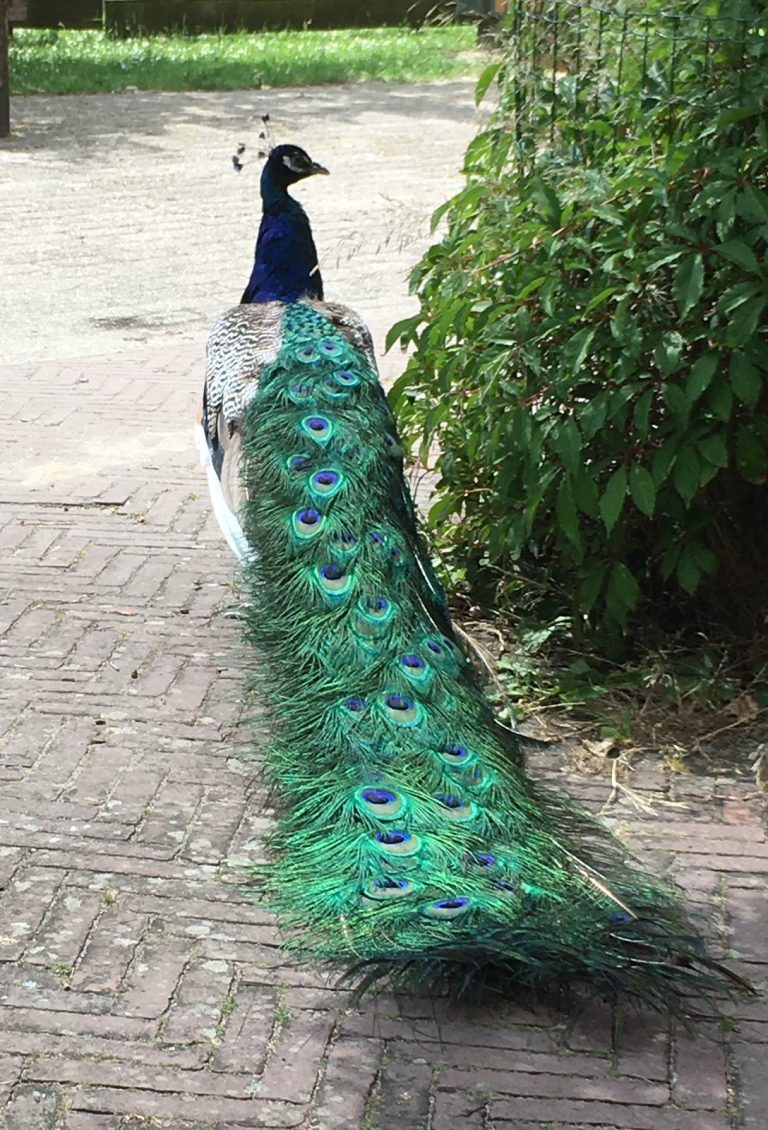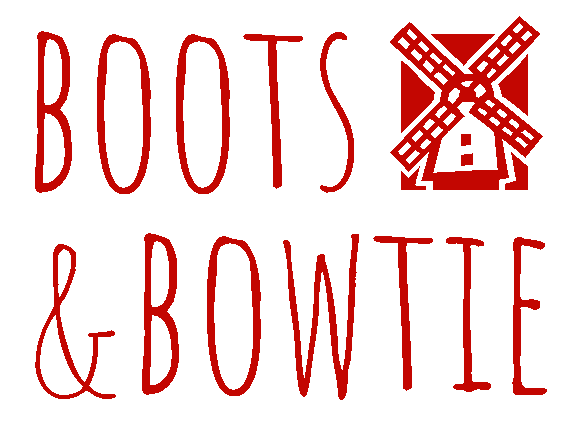Splendor in the Grass – Koppelsteede

(Please note: as of January 2021, Koppelsteede is closed to the public. Check their website if you’re planning to go.)
On a previous walk this summer along the old Roman border, while about to cross the freeway on our way to get gin, we found ourselves walking past what looked like a large farm, with a sign on a locked gate saying “Stadsboerderij Koppelsteede”. (Literally, a stadsboerderij is an urban farm, but they’re usually pretty low-key, like a petting zoo.)
Now this neighborhood, called Lunetten, is a kind of suburb from the 1980s, all scrupulously planned and efficient in its use of space. We were literally a stone’s throw (if you’re good at stone-throwing) from the huge cloverleaf freeway interchange that shares the name. We had noticed the name Koppelsteede on maps, but nothing about a farm, and had figured it was a scrap-metal dealer. Lunetten is all about modernity and efficiency. So a farm was a little out of left field. We figured it couldn’t be more than a small petting zoo with goats, chickens, rabbits, maybe a sheep or two; a place to distract the kids while their weary parents drink weak coffee made by a volunteer….
But there we were, looking in at this farm from its southern edge, and it was extensive – we could see what may have been beehives in a field of tall, flower-studded grass, what looked like vegetable gardens, hedgerows, and – intriguingly, especially in the Netherlands – we couldn’t see exactly where it ended.
We came back as soon as we could. From the farm’s main entrance (where you currently have to disinfect your hands, and respect the one-way foot traffic at marked entrances/exits) you can see acres of lovely pastures dotted with trees.
We thought we’d see what they had to offer in the way of refreshment – after all, we are Boots and Bowtie. Although a menu posted outside listed sandwiches, the restrictions have kept the tiny café’s selection limited to a homemade cake of some kind and drinks. We got a sort of shortbread-y cake (very nice) and cappuccinos. It’s currently all to-go, served in and on recyclable if not compostable items. We took our coffee and cake and found a place to sit, scanning our surroundings for a few drab little goats or rabbits behind the worn wooden fences. And who should we see sauntering towards us but a peacock?!

Mr. Peacock sat down too, his body in the shade and his fiery tail magnificently lit up in the sun, as if he knew, and didn’t care, that this would prevent our getting a decent photo. He seemed well aware he was was a class act in the humble petting zoo. Cue flashbacks to India, where we sat in the shade watching peacocks navigate the vine-covered stone walls of ruined palaces in the hot sun. As our cappuccinos morphed into masala chai, we fantasized about cool marble temples, perfumed fountains, rose gardens, and… were jolted out of our reverie by the screaming of a toddler. The peacock just sat there, regal and unfazed.
We left his company after finishing our coffee, and explored the animal pens. There are goats and lots of sheep, looking nonchalant. There are two enormous pigs – seeing the head of one sticking out of the door you form an idea of its size, then realize once you’re closer up that it’s even longer. It’s like when you’ve put the extension leaf in the dining-room table for the first time in years. The farm’s operators recognize their intelligence and need for play, for the pigs have toys and a large mud bath attached to their shed.
Petting zoos have an educational function. The signage on every pen here doesn’t beat around the bush. This one, we drink their milk. This one, we eat their meat. (None of the signs actually says “and to get that meat, we KILL them!!!” but if you’re old enough to read, you make the connection, and if you aren’t, well, ignorance is bliss.)
These happy specimens are the lucky ones; not only have their lives been spared, they’re doing very well – with food, shelter, even health care.
Continuing with the educational aspect, there are also various fish and other animals living in a big pond at the back of the farm. Kids can borrow a net and bucket and discover just what’s swimming around in the water.
Near the orchard there’s a small exhibit on the history of this little part of the neighborhood. It’s sad that so much of it had to make way for the freeway. On the other hand there are copies of some fascinating, centuries-old maps there and if you’re lucky a passionate volunteer will tell you more about the place’s history.
On our way to the exit, who should step out through a gate but Mrs. Peahen? (Yes, the female peacock is called a peahen!) As we turned to admire her, her chicks emerged one by one, six of them!

We came back a couple of months later and the peachicks (not to be confused with chickpeas) were looking fine, and a few already had those stunning tail feathers coming in. And none of the family was around during our next visit in December, and there was no one (human) around to ask about them. We hope they were indoors where it’s warmer, or maybe papa took them to the Maharaja’s winter palace.
So if you’re in or near Utrecht, this place is easy to get to and fun to visit. (Do check their website before you go to make sure they’re open and to see any restrictions). If you’re not up for a long walk, it’s about a 1-km walk from Utrecht’s Lunetten station and the #8 bus stops practically around the corner.
However, the journey can be almost as nice as the destination – you can walk there or back from the center of town along Tirol (streets all have geographical names) running towards the station, or go straight along Koppeldijk (becomes Goeree) to the Beatrixpark and follow the rails to the Vaartsche Rijn station, or any number of other ways. Boots and Bowtie says check it out.
Koppeldijk 115, Utrecht
